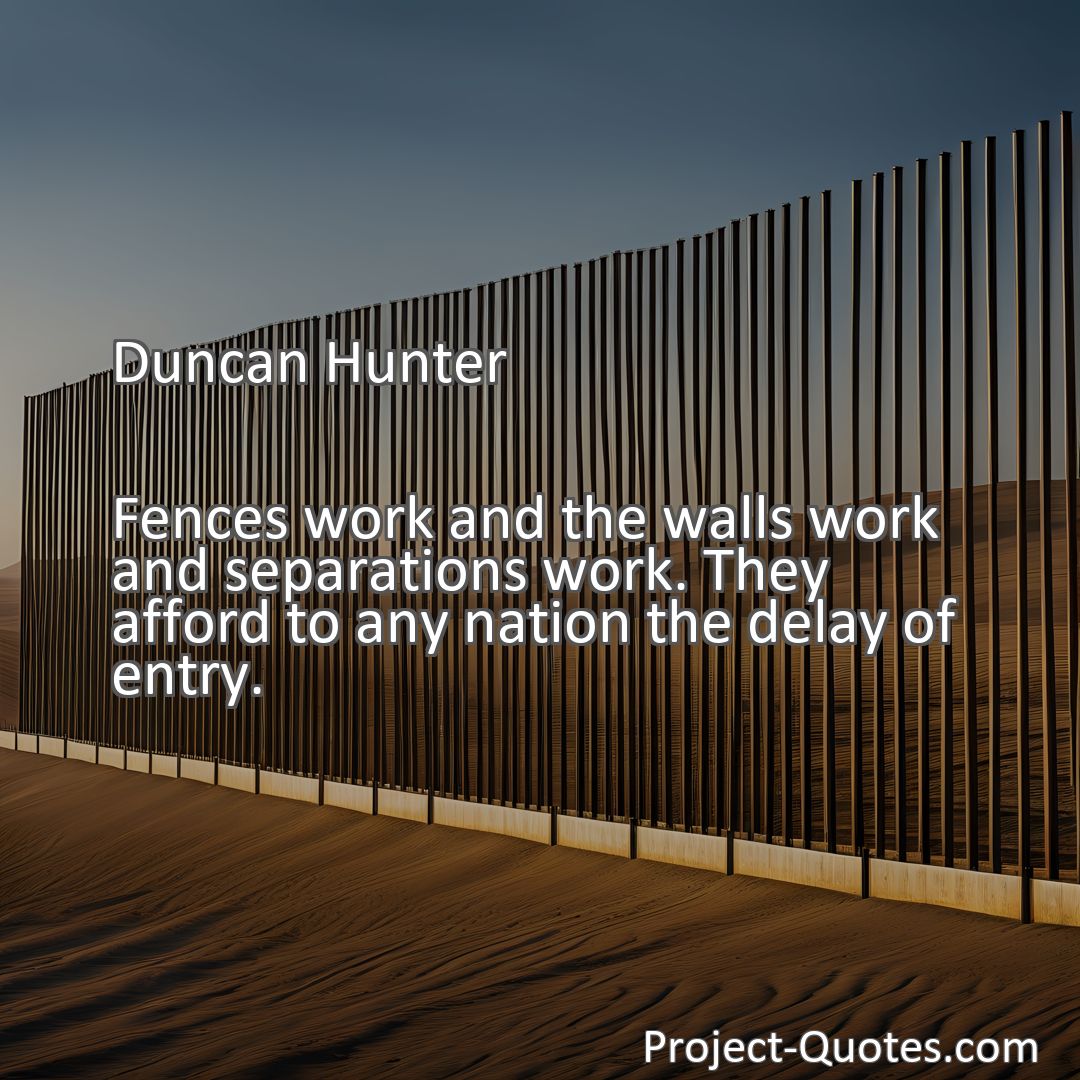Fences work and the walls work and separations work. They afford to any nation the delay of entry.
Duncan Hunter
Enhancing Border Security: How Structures Grant Border Patrol Agents Additional Time Discover the role of fences and walls in enhancing border security as they provide border patrol agents with crucial additional time to detect and apprehend individuals involved in criminal activities. Explore the historical perspective, psychological impact, economic implications, environmental concerns, technological advancements, and international relations involved in determining the relevance and effectiveness of physical boundaries in ensuring national security. Ultimately, find out how policymakers can make informed decisions that prioritize security while considering societal well-being.
Table of Contents
Meaning of Quote – Fences work and the walls work and separations work. They afford to any nation the delay of entry.
The Role of Boundaries in National Security: Examining the Efficiency of Fences and Walls
Introduction:
Boundaries, such as fences and walls, have long played a significant role in providing nations with a sense of security and control over their territories. As stated by Duncan Hunter, a prominent American politician, “Fences work and walls work and separations work. They afford to any nation the delay of entry.” In this essay, we will delve deeper into this notion, exploring the various perspectives on the efficacy of physical barriers in deterring unauthorized entry and their relevance in today’s world. Through a balanced analysis, we will shed light on the advantages and potential drawbacks of fences and walls as tools for national security.
Historical Perspective:
Throughout history, civilizations have employed physical barriers to safeguard their territories. Ancient civilizations, such as the Romans and the Chinese, constructed walls to protect their people from external threats. These barriers not only obstructed direct entry but also created a psychological deterrent, emphasizing the strength and determination of the defending nation. The iconic Great Wall of China, spanning over 13,000 miles, stands as a testament to the effectiveness of physical boundaries in preserving a nation’s sovereignty.
Enhancing Border Security:
In contemporary times, fences and walls continue to be utilized as measures to strengthen border control and mitigate potential security risks. Proponents of physical barriers argue that they aid in reducing illegal immigration, drug trafficking, and smuggling attempts. By creating obstacles, these structures grant border patrol agents additional time to detect, intercept, and apprehend individuals involved in criminal activities. This delay of entry helps prevent direct threats to the country and provides authorities with crucial time to respond effectively.
Psychological Impact:
Apart from their practical role, walls and fences also carry symbolic significance for nations and their citizens. They serve as a visual representation of a nation’s commitment to protecting its interests and maintaining its identity. Borders delineated by physical barriers act as demarcation lines, reinforcing a sense of unity among the populace, while simultaneously deterring the encroachment of external influences. In this sense, fences and walls contribute to a nation’s collective psyche, fostering a sense of belonging and instilling pride in its people.
Economic Implications:
Supporters of physical barriers argue that they not only safeguard national security but also have positive economic implications. By deterring illegal immigration and smuggling activities, fences and walls potentially reduce the strain on a nation’s resources and social services. This aspect is particularly relevant when considering the costs associated with healthcare, education, and public safety. A strong argument can be made that the implementation of physical barriers can help redirect funds towards domestic priorities, benefiting both citizens and legal immigrants residing within the country.
Environmental Concerns:
Critics of physical boundaries raise valid concerns regarding their potential environmental impact. Construction of fences and walls often involves the clearing of natural habitats, disruption of ecosystems, and alteration of wildlife migration patterns. Additionally, such barriers may impede cross-border cooperation on environmental issues, hindering collaboration and the sharing of resources between neighboring nations. To strike a balance between border security and environmental preservation, proponents argue for the implementation of sustainable practices and effective wildlife corridors.
Technological Advancements:
While fences and walls have been historically effective, opponents argue that technological advancements in surveillance systems, drones, and biometric identification render physical barriers somewhat obsolete. These technological innovations have the potential to provide real-time monitoring and identification of potential intruders, thus offering a more versatile and cost-effective solution for border security. Advocates for this viewpoint stress the importance of investing in state-of-the-art equipment rather than allocating substantial resources to construct and maintain physical barriers.
International Relations:
The construction of fences and walls also has implications for international relations, fostering debate and sometimes straining diplomatic ties between neighboring countries. Critics argue that visible border barriers may undermine trust and cooperation in addressing common challenges, leading to tension and animosity. In contrast, proponents contend that clear borders can actually foster stability, as they provide a defined framework for negotiations and dispute resolution. Striking a balance between security concerns and maintaining diplomatic relationships is essential for navigating the complex geopolitical landscape.
Conclusion:
In conclusion, the debate surrounding the effectiveness of fences and walls as tools for national security continues to provoke renewed discussions. While Duncan Hunter’s quote suggests that these barriers afford nations the delay of entry, it is crucial to delve deeper to understand the multifaceted effects they have on our society. Historical evidence, practical considerations, environmental concerns, technological advancements, and international implications must all be taken into account when evaluating the relevance and efficiency of physical boundaries in the modern era. By balancing these factors, policymakers can make informed decisions that prioritize both security and holistic societal well-being.
I hope this quote inspired image brings you hope and peace. Share it with someone who needs it today!


